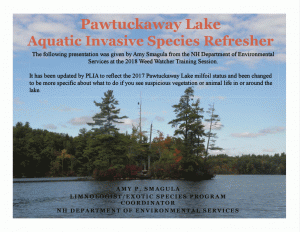 Amy Smagula, Chief Limnologist/Exotic Species Program Coordinator at NH Department of Environmental Services, has been working closely with the PLIA to identify, detect, and control aquatic invasive species in and around Pawtuckaway Lake. The slideshow presentation she has given at trainings is now available for all to view at the following link: PLIA Smagula Presentation 2018 We strongly recommend that anyone interested in the health of Pawtuckaway take a moment to learn about invasive species, especially milfoil!
Amy Smagula, Chief Limnologist/Exotic Species Program Coordinator at NH Department of Environmental Services, has been working closely with the PLIA to identify, detect, and control aquatic invasive species in and around Pawtuckaway Lake. The slideshow presentation she has given at trainings is now available for all to view at the following link: PLIA Smagula Presentation 2018 We strongly recommend that anyone interested in the health of Pawtuckaway take a moment to learn about invasive species, especially milfoil!
PLIA Local Hero Award for 2018
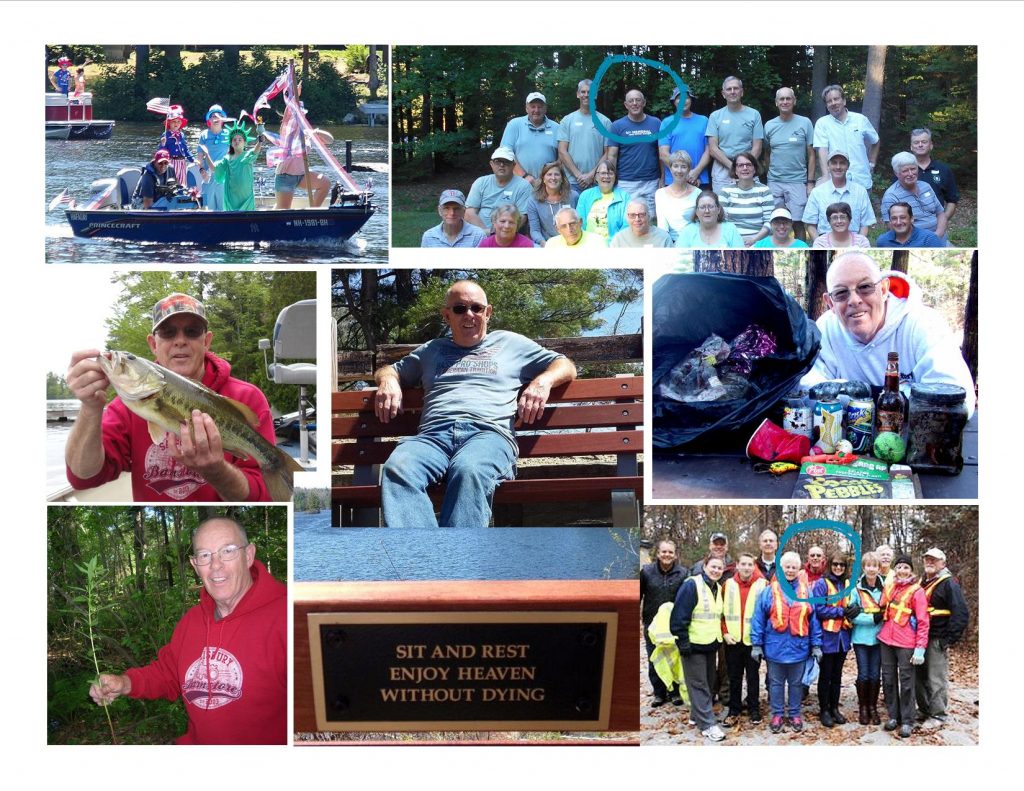
Don Roberge, Pawtuckaway camper, fisherman, and volunteer extraordinaire was chosen to receive the PLIA Local Hero Award at this year’s Annual Meeting of the PLIA. He was celebrated for his extraordinary efforts to conserve, protect, and improve Pawtuckaway Lake, largely from the campgrounds of the State Park where he loves to pitch his tent throughout the season. Although he is a resident of Manchester, Don has long been a fan of the lake and spends countless hours enjoying its beauty from his campsite and on his boat. He has volunteered with the PLIA’s Weed Watchers, has joined the crew on road cleanup days, and has stayed into the fall to help clean up the island trash that gets exposed when the lake level is lowered. He decorates his boat for the PLIA Fourth of July Boat Parade and recently even donated a bench to the State Park near his favorite campsite. It is situated specifically to watch the glorious sunsets from the North Channel, and Don recommends it for that purpose. But he also invites the public to rest and relax while their senses take in the beauty of the lake and its wildlife. Thank you, Don, for all you do!
Saturday is Annual Meeting Day

- Shoreland Protection Act–how does it affect you?
- Lake Hosting and the Clean, Drain, and Dry Campaign
- Naming the islands in Pawtuckaway
- Lakeside gardening–helping the lake stay clean
Are You Ready for Annual Meeting?
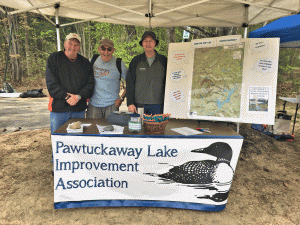 If you missed the PLIA table at Nottingham Earth Day on May 12th, don’t worry! We’ll have even more on offer at our Annual Meeting from 9:00 AM to noon on Saturday, May 19, 2018, at the Nottingham Town Offices, Community Gym. You can try your luck at our raffle, with prizes from ten different community businesses. Renew your membership–or join the PLIA–for a tax-exempt donation! There will be a slide presentation highlighting our activities and achievements in 2017. We will be bestowing an award to a Local Hero for uncommon service to the PLIA and Pawtuckaway Lake. There will be four breakout groups on various topics–in two sessions–so you can participate in two different discussions. Come at 8:30 for refreshments, raffle tickets, and schmoozing with friends and neighbors. There will be something for everyone! Read all about what’s planned in greater detail, in our Spring PawPrints newsletter.
If you missed the PLIA table at Nottingham Earth Day on May 12th, don’t worry! We’ll have even more on offer at our Annual Meeting from 9:00 AM to noon on Saturday, May 19, 2018, at the Nottingham Town Offices, Community Gym. You can try your luck at our raffle, with prizes from ten different community businesses. Renew your membership–or join the PLIA–for a tax-exempt donation! There will be a slide presentation highlighting our activities and achievements in 2017. We will be bestowing an award to a Local Hero for uncommon service to the PLIA and Pawtuckaway Lake. There will be four breakout groups on various topics–in two sessions–so you can participate in two different discussions. Come at 8:30 for refreshments, raffle tickets, and schmoozing with friends and neighbors. There will be something for everyone! Read all about what’s planned in greater detail, in our Spring PawPrints newsletter.
PLIA Annual Meeting Coming!

Town Offices, 139 Stage Road
8:30 – 9:00: Registration, membership, raffle tickets,
refreshments, T-shirt sales
Latest Edition of Pawprints
 The PLIA has published a second edition of its newsletter. This one is dedicated to our Annual Meeting coming on May 19, 2018. You can read the full edition, and find out what we have planned for everyone this year, here.
The PLIA has published a second edition of its newsletter. This one is dedicated to our Annual Meeting coming on May 19, 2018. You can read the full edition, and find out what we have planned for everyone this year, here.
PawPrints Newsletter–Early Edition
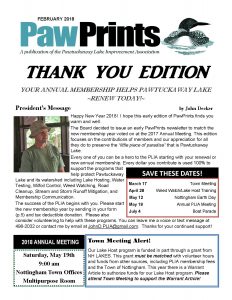 The PLIA recently mailed out its newsletter with an early edition to say ‘Thank You‘ to all its members and volunteers. You can read an electronic version–in color–here.
The PLIA recently mailed out its newsletter with an early edition to say ‘Thank You‘ to all its members and volunteers. You can read an electronic version–in color–here.
NH Lake Hosts Stop Milfoil from Entering Pawtuckaway Lake
Recently, the New Hampshire Lakes Association recognized our own Pawtuckaway Lake Hosts for their excellent work. In an article of its October newsletter “Shorelines”, the organization described an important discovery of invasive milfoil that was made in the course of boat and trailer inspections at the Fundy boat launch:
“Last week we found a large, mature piece of milfoil on a boat trailer coming from Massachusetts. If we had not been staffing the ramp on weekdays after Labor Day, that milfoil would have been in the lake.”
– Dee-Ann D., Lake Host Point Person for the Pawtuckaway Lake Association (PLIA)

“The PLIA has been working very hard during the past few years to help control the infestation of milfoil in Pawtuckaway Lake—thank goodness a Lake Host was at the NH Fish and Game Fundy Access site on October 1 to prevent this piece of milfoil from hitchhiking into the lake. Had a Lake Host not been at the ramp at the time, it’s possible that all the time and money the PLIA and its partners have spent over the past few years trying to control the milfoil growth in the lake would have been in vain!
Thank you to all the Lake Hosts at Pawtuckaway Lake—and at all our lakes—for being there to protect our lakes from the spread of invasive species, one boat and boater at a time!”
In addition, milfoil was also discovered on its way into the Fundy and removed in late September, so our gratitude goes to these wonderful Lake Hosts – both paid and volunteer – for making this program such a success.
Fall Roadside Cleanup
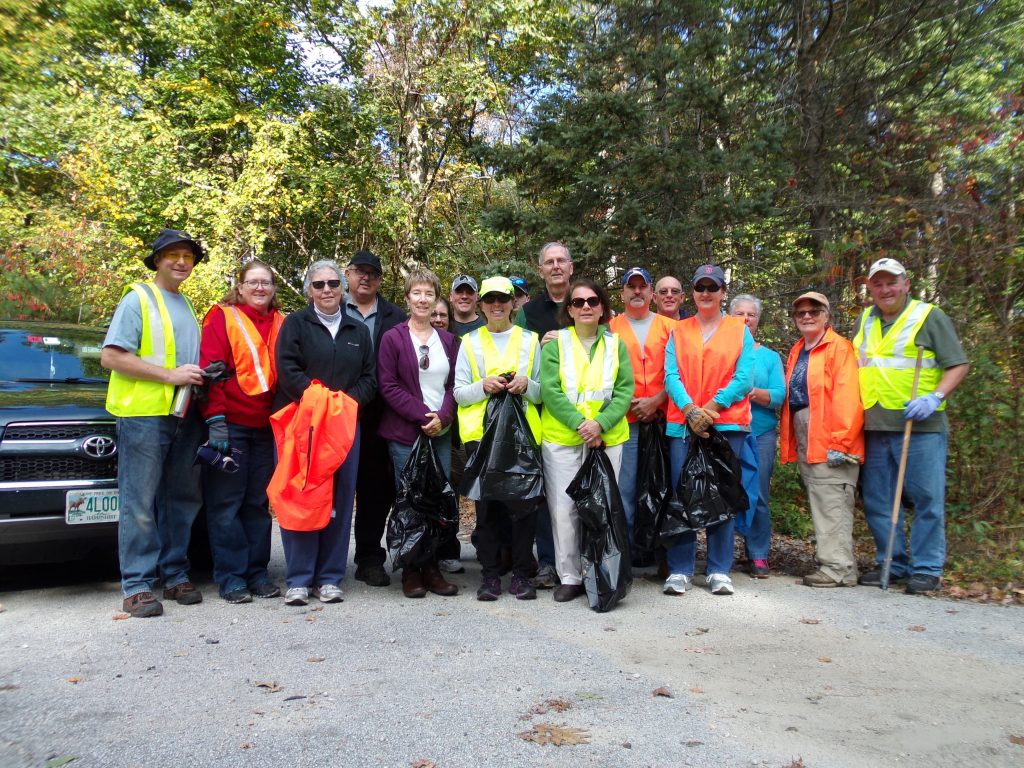 Twice a year, PLIA volunteers gather to spend an hour fanning out along both sides of Route 156 between the signs bearing our name on them. Spring and fall, volunteers in reflector vests scan the roadside, collecting and bagging trash. It is a program of which the PLIA is very proud, and is one way we are able to give back to the community. Plus, believe it or not, we have fun in the process!
Twice a year, PLIA volunteers gather to spend an hour fanning out along both sides of Route 156 between the signs bearing our name on them. Spring and fall, volunteers in reflector vests scan the roadside, collecting and bagging trash. It is a program of which the PLIA is very proud, and is one way we are able to give back to the community. Plus, believe it or not, we have fun in the process!
On Saturday, October 14, the PLIA had the biggest turnout ever for trash pickup along the highway! Truly a perfect example of the adage, “many hands make light work”. We had the entire strip of highway under our responsibility clean in record time and had a nice visit with friends and neighbors at the same time.
Thanks to all who volunteered!
ONLY FIVE MORE DAYS TO VOTE FOR $5,000!
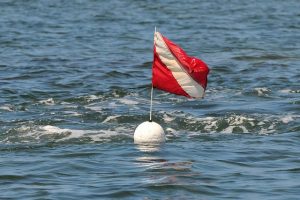 The Cox Conserves Heroes Award, in recognition of the volunteer work that Neil Santos has been doing to search for variable milfoil in Pawtuckaway Lake, has already benefitted the PLIA with a $5,000 grant. This is your chance to vote for Neil and increase the chances of an additional $5,000 award if he gets more votes than the other two finalists in this program.
The Cox Conserves Heroes Award, in recognition of the volunteer work that Neil Santos has been doing to search for variable milfoil in Pawtuckaway Lake, has already benefitted the PLIA with a $5,000 grant. This is your chance to vote for Neil and increase the chances of an additional $5,000 award if he gets more votes than the other two finalists in this program.
Please act now to register you vote at this website. Click on the VOTE button under Neil’s picture that links to the form for voting. Tell your friends, neighbors, and colleagues about this wonderful opportunity to fund milfoil control activities on Pawtuckaway and to preserve it for recreational enjoyment and wildlife habitat in many years to come.
Voting ends on September 25th, so don’t put off this important and beneficial chance to speak up for conservation. Your vote counts!
The PLIA thanks you and Pawtuckaway Lake thanks you!